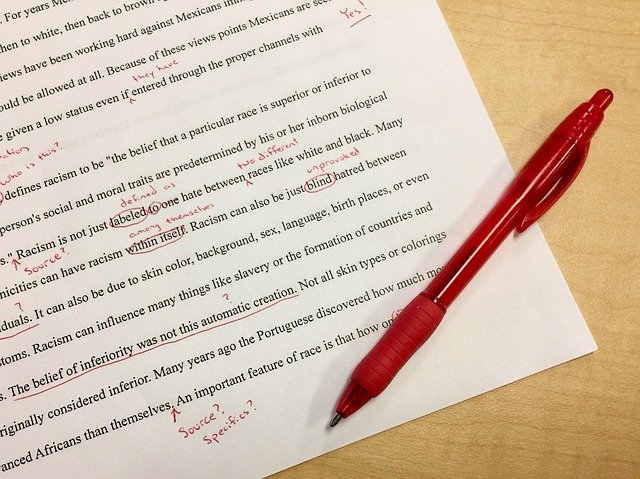
The Six Types of Editing: Knowing Which Is the Right One
THE SIX TYPES OF EDITING: KNOWING WHICH IS THE RIGHT ONE
Legendary novelist Stephen King once said, “To write is human, to edit is divine.”
Indeed, nothing is perfect the first time. Writing is no exception. Effective writing requires a progressive approach. No matter how good writing is the first time, a good edit can take a text from good to great.
When readers lay their eyes on a finished piece, they see the result of writing, editing, proofreading, and fact-checking. These processes all play a significant role in producing great literary pieces. The trick is recognizing how editing could improve good writing.
In this article we will explore the six types of editing. We will also discuss how writers and editors can take advantage of these editing types to take great writing to the next level.
The Six Types of Editing
1. Developmental Editing
Developmental editing refers to an arduous process of producing major edits on a partially or fully completed manuscript. As such, this type of editing also receives the name of “substantive” or “line” editing.
Developmental editing entails “significant structuring or restructuring of a manuscript’s discourse.” Therefore, developmental editing significantly alters the text’s nature and composition. In some instances, these edits can shift storylines or transform the prose itself.
In Scott Norton’s comprehensive guide to developmental editing, editors “provide broad direction by helping the author to form a vision for the book, then coaching the author chapter by chapter to ensure that the vision is successfully executed.”
Consequently, editors may choose to work closely with a writer to guide them throughout the writing process. This coaching support does not suggest the editor will act like a schoolteacher. The author may lean on the editor in terms of “big picture” items such as themes, storylines, or character creation.
Additionally, developmental editors may choose to “get their hands dirty with the prose itself, suggesting rewrites at the chapter, section, paragraph, and sentence levels.” This approach is akin to the editor taking a red marker to highlight the changes needed. The extent of the changes depends on the editor’s willingness to drill down on the prose itself. Thus, major rewrites may stem from detailed developmental editing.
In fiction writing, developmental editing generally focuses on plotlines and character building. Editors may suggest specific changes to the story itself or request major rewrites to fix plot holes or inconsistencies.
In nonfiction writing, a developmental edit focuses on reviewing cohesion among concepts, themes, and topics. Also, editors may suggest rewrites to match tone, voice, or style (academic, casual, or general).
The outcome of a developmental edit is an annotated manuscript. It consists of notes made directly on the manuscript, either directly on a hard copy or an electronic one.
Also, an editor may produce an editorial report. This report contains general notes on the manuscripts with some specific examples. Editorial reports generally emerge from finished drafts, whereas annotated manuscripts best serve a chapter-by-chapter review.
2. Editorial Assessment
An editorial assessment is a great option for works in progress. Writers looking for feedback can turn to an editor to get a bird’s-eye view of a working manuscript. Thus, an editorial assessment intends to provide general guidelines on the main plot lines or thematic issues.
A solid editorial assessment can reveal early plot issues, character contradictions, thematic inconsistencies, or even factual inaccuracies.
Editor and writing conference founder Rebecca Faith Heyman describes an editorial assessment as a “tough-love letter from an editor to an author.”
This concept emerges from the premise that an editorial assessment is an unbiased critique of the manuscript. In consequence, this critique opens the door for some unpleasant feedback. Nevertheless, feedback is necessary to ensure the overall quality of the work.
The most significant advantage of an editorial assessment is timely feedback. Since the manuscript is still in progress, the writer can go about making changes without significantly altering the manuscript. Timely feedback allows writers to save time and effort moving forward.
Conversely, edits on a final manuscript would constitute a developmental edit. Naturally, major edits on a finished draft would be more time-consuming and laborious than on a work in progress. Hence, writers should always be open to the notion of an editorial assessment.
Editors produce a report in a letter format stating their recommendations following their assessment. This report generally contains broad points on the main aspects of the manuscript. While specific examples may serve to highlight an issue, an editorial assessment does not focus on details.
Therefore, this assessment does not constitute proofreading or fact-checking. These elements are part of the developmental assessment or specific proofreading and fact-checking procedures.
Writers should seek an editorial assessment if they feel unsure about their manuscript’s quality. As such, an editor can help the author transform their vision into a coherent piece. Writers could employ an editor themselves for a fee. Also, editors may work on a publisher’s behalf as part of a book development process.
Please bear in mind that editorial assessments should yield positive feedback. Therefore, writers should not take observations personally. Hence, an editorial assessment is an exercise in “tough love.”
3. Structural Editing
As its name suggests, structural editing focuses on a literary piece’s construction.
For fiction books, structural editing often centers around plot construction, narrative, and story elements. For instance, a structural edit focuses on ensuring that the sequence of events in a story line up appropriately.
Also, story elements need to match according to the main plot events. As such, a solid structural assessment provides writers with specific feedback on the story’s overall construction.
For nonfiction books, the structural edit focuses on the book’s organization and formatting. Particularly, nonfiction books must focus on coherence throughout their development.
This coherence pertains to the main theme and congruency among chapters. Hence, a solid structural edit should point out inconsistencies in tone (casual, academic, or general) and narrative (first-person or third person).
There is often confusion between structural editing and proofreading. While structural editing may underscore grammatical and spelling issues, it is not its main objective. A profound structural edit may reveal linguistic issues such as overuse of the passive voice, inconsistent punctuation, or common spelling mistakes. However, this editing would only highlight examples of such issues.
A structural edit may also tackle a writer’s tone and narrative in a fiction piece. Generally speaking, editors focus on a consistent narrative style. Also, the editor may suggest changes to pacing and overall tone.
For example, the narrator may lack engagement with a climactic scene in the story. Additionally, a character’s voice might not match its persona. Consequently, an editor would point out this issue.
Also, structural editing in fiction may lead to storylines broken up into different chapters or splitting the story into different volumes. Moreover, this editing may recommend specific parts be cut out from the story. While the aim is not to interfere in the creative process, these edits establish a cohesive story throughout the book.
Editors generally write a report that lists the major issues that require attention. The report might include specific examples to highlight the edits required. However, the editor may not go into greater detail until the developmental editing phase. Therefore, the structural edit should provide the author with guidelines to ensure the book’s structure adheres to the story or theme’s overall vision.
4. Copyediting

After completing developmental and structural edits (including an editorial assessment), the copyediting process is ready to begin. In general, copyediting reviews a finished manuscript for linguistic errors.
The copyediting process, also known as “line editing,” focuses on the areas of spelling, grammar, punctuation, capitalization, word choice, dialogs, narrative, and inconsistencies (character depictions, scenes, location). As such, copyediting is an arduous process that looks to address linguistic aspects in addition to story elements.
Copyediting is the next step following a developmental edit. Also, a thorough copyedit can stem from an editorial assessment.
Both developmental edits and editorial assessments address “big picture” issues. These assessments provide broad strokes on the working manuscript’s quality. Once finished, copyediting does a deep dive into the manuscript’s construction. Therefore, the copyediting process may reveal problems that may need a revision or even a rewrite.
The copyediting process does not constitute the final step before publication. Copyediting intends to refine a final manuscript so the author can put the finishing touches on it.
Moreover, copyediting is not “beta reading.” Beta readers are untrained audience members who provide feedback on the story prior to publication. Therefore, copyediting constitutes a quality assurance process meant to ensure a high-grade publication.
Also, please note there is a difference between line editing and copyediting. While line editing and copyediting are generally synonymous, copyediting encompasses a global review in which both linguistics and prose receive consideration. However, line editing hones in on text flow. As such, line editing involves improving the readability of text as opposed to focusing specifically on linguistic elements (grammar, spelling, or word choice).
The copyediting process may break down into two separate parts: line editing and proofreading. On the whole, proofreading is generally the final step in the quality assurance process. Therefore, line editing becomes an integral part of the review process. After all, a trained editor can provide valuable insight into the story’s overall flow and development. Consequently, line editing allows authors to capture anything that might fall through the cracks.
Lastly, copyediting does not provide any insight into creative issues. Recommendations on creative matters are the domain of developmental editing or editorial assessments. Therefore, the copyediting process should not yield any creative guidance.
If a copyeditor feels there are major creative matters to address, the copyediting review might become a developmental edit. Hence, copyediting should occur only after a developmental edit and editorial assessment have taken place.
5. Proofreading
Proofreading generally represents the final step prior to publication. At this stage, the manuscript is final. As such, the manuscript will not undergo any further developmental edits.
Since the story is complete, the manuscript must now undergo an exhaustive linguistic review. This review entails checking grammar, spelling, punctuation, voice, and any other linguistic items that comprise the book.
In fiction pieces, proofreaders check all linguistics components. In addition, proofreaders check to ensure consistent spelling in names of characters, places, and events. Moreover, proofreaders ensure that the prose is consistent with the convention of British or American English.
Proofreading tends to be a painstaking and time-consuming process. Therefore, proofreaders may work on a chapter-by-chapter basis. This approach reduces the overall time needed to check an entire novel.
Please bear in mind that authors should communicate any creative liberties in the text. For example, the uncommon spelling of names, fictional places, or slang should comprise notes submitted along with the manuscript. These notes receive the name of “style sheet.” A style sheet is quite common in fantasy novels.
For nonfiction works, proofreaders go over additional aspects such as graphs, illustrations, tables, font, and citations.
Authors should disclose their citation format. For instance, the author must indicate the use of MLA, APA, Harvard, or Vancouver citation styles. Therefore, proofreaders must be familiar with these citation styles. It is worth noting that a copyediting review may reveal citation errors. Thus, authors may enlist a proofreader’s services to review citations specifically.
Proofreading also addresses specific formatting issues. Formatting includes font type, font size, margins, spacing, page numbering, line counts, or paragraph alignment. Some publishers may have very specific requirements. Consequently, an experienced proofreader can help meet those specifications, thereby ensuring the final draft meets publication requirements.
Additionally, more than one proofreader may participate in this process. For example, one expert may check citations and formatting while another may focus solely on linguistic issues. In other instances, several proofreaders may go over stylistic and linguistic issues to double-check edits. This process is common when major rewrites occur in a working manuscript.
6. Fact-Checking Review

A fact-checking review may be required, particularly in nonfiction works. Fact-checking reviews focus exclusively on verifying the accuracy of information presented in the text.
While the author may be a renowned expert on the subject matter, fact-checkers dig deep into the claims presented in the text. This approach ensures 100 percent accuracy of the information provided in the book.
There are various reasons why fact-checking is immensely important. First, fact-checking ensures complete accuracy in the text. Thus, total accuracy builds the author’s credibility. Naturally, a recognized authority on a subject cannot afford criticism for inaccurate claims.
Second, a fact-checking review ensures the accuracy and reliability of sources. This process is particularly important in academic works.
When authors present their sources, fact-checks make sure these sources are precise and contain updated information. When authors fail to disclose sources, fact-checkers may do some digging to find support. If no support is available, then fact-checkers may recommend editing claims. In some instances, authors may have to remove claims altogether.
Third, fact-checking verifies figures and dates. In particular, a developmental editor may request a fact-checking review in the manuscript’s early stages. This recommendation may occur on a chapter-by-chapter basis to avoid any major rewrites at the latter stages of the book’s production.
Fiction works may also require a fact-checking review. Novels based on real historical events may need a fact-checking review to determine if any plotlines conflict with facts.
Of course, novels do not necessarily need to ensure accuracy. Nevertheless, a developmental edit might pick up story elements that make the plot implausible. For instance, stating that John Doe fell asleep in a hotel in Singapore, but then met a friend in a café in New York early the next morning would hardly be possible. Therefore, a fact-check edit would suggest that the author re-think his or her timeline.
Fact-checking, like proofreading, ensures that nothing slips through the cracks. Ultimately, these processes ensure high-quality materials.
Conclusion
Editing is a crucial process in book production. Therefore, writers and publishers must be open to employing editors’ services throughout a book’s creation. Indeed, no manuscript is perfect right from the start. As such, writers need to be open to improvements.
The type of editing utilized depends on the stage of the book’s development. During its early stages, a developmental edit can help the author refine a book. In doing so, copyediting, proofreading, and fact-checking can take place uneventfully.
Ultimately, editing serves to ensure the writer’s vision comes to fruition by delivering high-quality content to readers. This process not only fosters credibility but also saves time and unnecessary effort. Timely edits can reduce the likelihood of major rewrites, thereby facilitating the overall publication process.
Related Content
- 0 Comment
Subscribe to Newsletter
- How Can SharePoint Be Used To Organize and Disseminate SOPs?
- Planning the Perfect Genealogy Research Trip: A Step-by-Step Guide
- From Silly to Awesome: How Words Change Meaning Over Time
- The Psychology of Font Choice: How Typography Impacts Content Engagement
- How to Distribute SOPs for Maximum Usability



